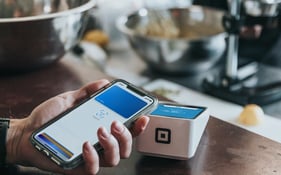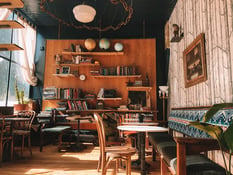Time was, you could take for granted your neighborhood coffee place, a stopover for procuring the magic bean elixir that gets you through your workdays. Then came the pandemic and a year of juicing K-cups. In this sorry state we came to realize that the coffee shop was more than a mere fuel station. It was an oasis where we exchanged banter and birthed big ideas and once in a while to offer a book recommendation or maybe a phone number scribbled in ballpoint on a brown napkin.
Decent joe alone does not a superb coffee shop make, because the shop has always been about more than the coffee. If you spent your past year sketching your coffee shop business plan onto boring ol’ kitchen paper towels, you’re going to want to consider the tech side of your operation, so the shop (and, yes, the joe) get into a flow. We asked Science on Call’s Luisa Castellanos, an all-purpose tech consultant for restaurants, to help us build out an optimal coffee shop tech stack.
How to pick a POS for a coffee shop
Though first used as a ritual sacrament in its native Ethiopia, coffee has been closely linked to cash throughout the better part of its long history. Historian Steven Topik goes so far as to assert that, “as a stimulant and as a precious commodity, coffee has been well suited for inspiring the rise of capitalism.” When you think of it that way, the term “point of sale” might well be gibberish in a coffee-less alternate universe! But we’re here in this universe, and the coin of this realm is, well, coin.
For many restaurants (such as pizza shops) the overwhelming default for a POS is Toast. But in coffee land (as with food trucks) the de facto standard is Square. “It doesn’t have all the bells and whistles of Toast, but that’s perfect in the context of coffee,” Castellanos says. “In a coffee shop, you typically don’t have different menus for different times of day, and you don’t have to worry about bringing food out at certain times, since service tends to be walk-up.”
Of course, selecting a POS is a personal process. There’s a reason the wheel of restaurant tech features such diverse POS options — every business owner has particular needs, on down to mobility and hardware. So start by thinking about the long-term. In the next five years, how do you want to grow? And how will a given system weather that change? Nowhere is this more paramount than in the coffee game, where expansion is often a part of life, if you do it right.
“A lot of our customers get really frustrated with the support that’s available for some of the more ‘old-school’ systems, like Micros and NCR,” Castellanos says. But once you scale up with a given system, you’re effectively wedded to it. “Let’s say you went with Micros in the beginning. If you find yourself with 30 coffee shops, to pull Micros out and install Square or Toast across each of them — that’ll cost you something in the ballpark of a hundred grand.”
Your coffee loyalty program and digital marketing
Coffee joints are a dime a dozen, so leverage your tech to ensure that your customers think of you when they jones for a jolt. One way to do this: our old pal direct email marketing. Your humble wi-fi landing page offers a surefire way to collect patrons’ email addresses — and if you ask nicely, their phone number, birthday, and social media handles. Once you have their contact, you can design a loyalty program that gets them coming back, whether you’re giving them their 10th cup for free or making sure they get a chonky pink cupcake on their birthday.
Unless you’re a data maximalist, though, you might wind up with more digital clutter than you care to futz with. “A single-location coffee shop might think they want something like that, but you have to go through a lot of steps just to set up a complicated loyalty program,” Castellanos says. “And you have to have enough staff to keep track of all the data you collect. It ends up more trouble than it’s worth, just to send coupon codes to your top five customers or whatever.”
This brings us to a golden rule of loyalty tech: If it’s creating a ton of work for you, it’s probably not worth your investment. “The independent coffee shops we work with usually end up canceling after they get these services,” Castellanos says. “Most of the features aren’t being used at all, and they cost a lot of money, when our customers are trying to save money in the first place.” Science on Call built a cheap ($25/month) and easy Science Guest product that provides a simple branded landing page to help you collect and compile email addresses. One selling point: Science_Guest lets you own your customer data, not whoever it is that keeps bombarding your guests’ inboxes with emails from KetoBased DietMiracle. (A second golden rule of loyalty tech? Don’t create spam for your customers.)
The evolution of loyalty programs, and one you might build into your model as early as possible, is a coffee subscription. Science on Call works with the hip Los Angeles-based Go Get ‘Em Tiger, which sends subscribers new roasts every week or month. Intelligentsia Coffee’s subscription service lets customers customize their deliveries down to the grind and the packaging. Single-location shops might opt for simpler subscription models, or just sell individual bags of brew. Heck, you can even make the 10th one free.
Get your website and e-commerce up and running
If you need to build a site from scratch, again, Square is an easy pick. “They actually bought Weebly a few years ago, so they have their own web builder too,” Castellanos says. “Square Online makes it really easy to mark things out of stock, and it integrates with Cuboh, so it takes care of order aggregation.” And yes, in a Covid era, you gotta give your customers an option to order ahead. No one wants to spend any more time in a line than absolutely necessary.
If you’ve got a webpage but you need to modernize it, look into Joe Coffee, an all-in-one marketing, ordering, and e-commerce tool engineered for independent coffee shops. In keeping with its commitment to small businesses, Joe’s online ordering solution is on the affordable end of the spectrum, and it integrates seamlessly with Square, and its marketplace app makes it easy for you to attract customers with hassle-free custom promo codes and flash discounts.
The in-store coffee shop experience
You know what people would love, now more than ever? To get out of their house, and into your shop. So don’t short your in-store experience. Your most loyal loiterers will expect fast, steady Wifi, so once you lock that in with your local provider, perhaps consider what happens when they bobble something. Science on Call offers an affordable back-up internet service that automatically switches your shop over to a secure 4G LTE network.
Your modern-day Gertrude Stein also requires more than just a writing outlet. Yeah, she also needs to plug in. Sounds simple, but even the simplest wiring plans go awry. “Sometimes businesses come to us because their architect and their designer didn’t communicate,” Castellanos says. “We end up having to run cables from one end of the shop to the other, because things aren’t where they need to be.” Do the front-end work to avoid creating a den of extension cords.
The last thing to consider, when you lay out the perfect vibe, is the correct amount of noise. You don’t want a crypt where people feel too self-conscious to gossip. You also don’t want to create some kind of subterranean Berlin disco that requires a password to get into. Play some music, in other words (emphasis on “some”). Your civilian Spotify licence doesn’t allow you to plug into a commercial sound system, so if you’re the kind of person who follows rules, you may want to scope out Soundtrack Your Brand, which specializes in filling little shops like yours with tunes for about $20 or $30 a month.
[Photo by Helena Lopes on Unsplash]





